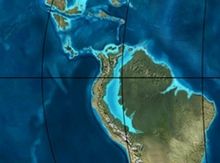Bogotá Formation
| Bogotá Formation Stratigraphic range: Late Paleocene-Early Eocene 61.66–52.5 Ma |
|
|---|---|
| Type | Geological formation |
| Underlies | Regadera Formation |
| Overlies | Cacho Formation |
| Thickness | 169–1,415 m (554–4,642 ft) |
| Lithology | |
| Primary | Mudstone, shale, siltstone |
| Other | Sandstone |
| Location | |
| Coordinates | 4°29′18.4″N 74°08′08.5″W / 4.488444°N 74.135694°WCoordinates: 4°29′18.4″N 74°08′08.5″W / 4.488444°N 74.135694°W |
| Region |
Bogotá savanna & Eastern Hills, Altiplano Cundiboyacense Eastern Ranges, Andes |
| Country |
|
| Type section | |
| Named for | Bogotá |
| Named by | Hettner |
| Location | Ciudad Bolívar, Bogotá |
| Year defined | 1892 |
| Coordinates | 4°29′18.4″N 74°08′08.5″W / 4.488444°N 74.135694°W |
| Approximate paleocoordinates | 2°06′N 62°24′W / 2.1°N 62.4°W |
| Region | Cundinamarca |
| Country |
|
 Paleogeography of Northern South America 50 Ma, by Ron Blakey |
|
The Bogotá Formation (Spanish: Formación Bogotá, E1-2b, Tpb, Pgb) is a geological formation of the Eastern Hills and Bogotá savanna on the Altiplano Cundiboyacense, Eastern Ranges of the Colombian Andes. The predominantly shale and siltstone formation, with sandstone beds intercalated, dates to the Paleogene period; Upper Paleocene to Lower Eocene epochs, with an age range of 61.66 to 52.5 Ma, spanning the Paleocene–Eocene Thermal Maximum. The thickness of the Bogotá Formation ranges from 169 metres (554 ft) near Tunja to 1,415 metres (4,642 ft) near Bogotá. Fossils of the ungulate Etayoa bacatensis have been found in the Bogotá Formation, as well as numerous reptiles, unnamed as of 2017.
The formation was first described by Hettner in 1892, then by Hubach in 1931, 1945 and 1957, and named in 1963 by Julivert after the Colombian capital Bogotá and its savanna.
The Bogotá Formation consists mainly of grayish-red, locally purplish, commonly greenish-gray, generally poorly stratified mudstone and silty claystone. Lithic arenite sandstone lenses, ranging from fine- to medium-grained, generally friable and variegated, are local constituents. Carbonaceous material is present as thin beds of low-grade argillaceous coal, north of Bogotá. Fossil remains of Etaoya bacatensis, named after Colombian geologist Fernando Etayo and the indigenous name for the Bogotá savanna, Bacatá, have been found in Ciudad Bolívar, close to the type locality of the Bogotá Formation. Additionally, pollen of Foveotriletes margaritae, Proxapertites operculatus and Foveotricolpites perforatus have been found, used for dating the formation. Other pollen, as Ulmoideipites krempii, Carpolithus and Hickeycarpum peltatum have been found in the Bogotá Formation. The abundant paleosols of the Bogotá Formation show an increase in chemical weathering across the Paleocene-Eocene (P-E) transition; the Paleocene–Eocene Thermal Maximum.
...
Wikipedia
